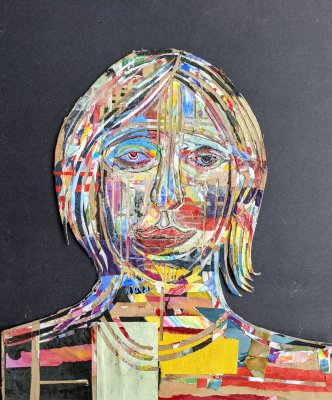Materials
- Various pieces of paper (magazines, old books, junk mail, old wrapping paper, newspaper, etc.)
- Glue
- One large piece of cardboard, tag board, or a very thick piece of paper
- A drawing utensil (pencil, pen, etc.)
- Scissors (optional)
Vocabulary
Abstract: when a work of art uses shape, line, and color that do not clearly represent things we see in the world
Manipulate (within art): the skillful handling, controlling, or use of something
Discussion and Video
Begin by using the Teaching Tips and Tools for Discussion, or you can have students self-guide themselves using the Tools for Looking at an Artwork. An example of how to bring in information about the artist from something your student observes: It may look like layers and layers of textured paint, and although Bradford refers to his works as paintings, he doesn’t actually use paint! The artist uses paper—including comic books, wrapping paper, etc.—often collected from around his neighborhood and from places he visits.
Next, watch the following video:
Begin a discussion with your students by asking the following questions:
- What are your initial thoughts on Bradford’s approach to his practice?
- Is there a color that you connect to? How does it reflect your identity?
Read the following:
To make Butch Queen, Bradford collaged black and white paper to canvas, sometimes splashing the black paper with bleach and water. He then cut into the thickly stacked paper fragments with a sander, creating a layered surface that emulates the strata of paper advertisements one passes while walking on city sidewalks and also suggests the variegations of human skin. While the resulting work is abstract, the artist sees its process and materials as deeply connected to contemporary life and his own experience as a black gay man.
Artmaking Activity
Overview: In this project, students will explore the process used by Mark Bradford, and use it as inspiration for creating their own work of self-expression.
Ask students to gather random paper materials, including magazines, old books that they no longer want/need, junk mail, old wrapping paper, newspaper, etc. Next, they should organize the papers by color, and then see which colors they most identify with for this project. Students should decide if they want their work to focus on one or multiple colors.
Encourage students to draw an outline of something that represents them. It can be an image in their own likeness, a favorite object, someone close to them, etc.
Next, show students how to rip the found paper into thick strips. They should do this to all of the paper they have chosen to use for their work. During this process, show them how they can be mindful of placement, do they want the strips to be randomly placed, or organized in a wave or grid-like pattern? Encourage them to proceed whichever way feels natural to them.
Next, they should begin gluing down their strips inside the outline they have drawn. They should continue to glue down all of their strips until they have a few layers. Then they should let the work dry.
Next, students are to take sandpaper, or something to scrape with, and begin removing parts of their work.
Ask:
- What happens to the paper when you use that material?
- Do the colors change? Does the texture change?
- Do you like how it looks? Why or why not?
Lastly, students can add lemon juice or vinegar to sections of their work to make it look like they used bleach. (Bradford uses bleach, but students can experiment with other materials.) Show them how to carefully place the liquid (using a dropper, if available) onto parts of the paper to manipulate certain sections of their work.

